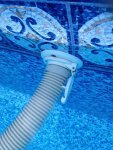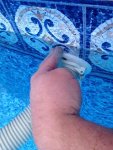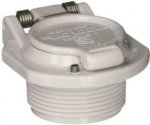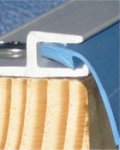Hi - I am really hoping to get some help here.
Today I opened our pool for the summer, and noticed that I have air bubbles being blown into the water by all of the water inlet jets (pressure side). So i know that bubbles are usually a problem on the suction side, so I did some tracing, and found that I have a leak (audible) where my pool vacuum plugs into a port in the side of the pool (not the skimmer, but a dedicated port).
The pool is an in ground, vinyl lined pool. When I push on the vinyl around the port, I can hear the suction change, so I know that is where the leak is. My fear is that the port cracked during the winter. This port is where the suction/vacuum hose plugs in, and has a little spring loaded cover. I don't think the cover is the problem, but rather behind the vinyl liner - so I think the threaded PVC port may have cracked.
Is there a way to fix this without cutting into the concrete decking and digging down? The wall behind the vinyl is some type of foam block, but it is reinforced with rebar and concrete. So going through the wall doesn't sound like an attractive option either. Is there some type of glue or epoxy that can seal the leak, but that let's me somehow restore the threads (if they get covered) so I can insert and remove the cover? (I plug it in the winter)
I want to fix it right (i.e. not seal it up), but am looking for options?
Thanks!
Today I opened our pool for the summer, and noticed that I have air bubbles being blown into the water by all of the water inlet jets (pressure side). So i know that bubbles are usually a problem on the suction side, so I did some tracing, and found that I have a leak (audible) where my pool vacuum plugs into a port in the side of the pool (not the skimmer, but a dedicated port).
The pool is an in ground, vinyl lined pool. When I push on the vinyl around the port, I can hear the suction change, so I know that is where the leak is. My fear is that the port cracked during the winter. This port is where the suction/vacuum hose plugs in, and has a little spring loaded cover. I don't think the cover is the problem, but rather behind the vinyl liner - so I think the threaded PVC port may have cracked.
Is there a way to fix this without cutting into the concrete decking and digging down? The wall behind the vinyl is some type of foam block, but it is reinforced with rebar and concrete. So going through the wall doesn't sound like an attractive option either. Is there some type of glue or epoxy that can seal the leak, but that let's me somehow restore the threads (if they get covered) so I can insert and remove the cover? (I plug it in the winter)
I want to fix it right (i.e. not seal it up), but am looking for options?
Thanks!





